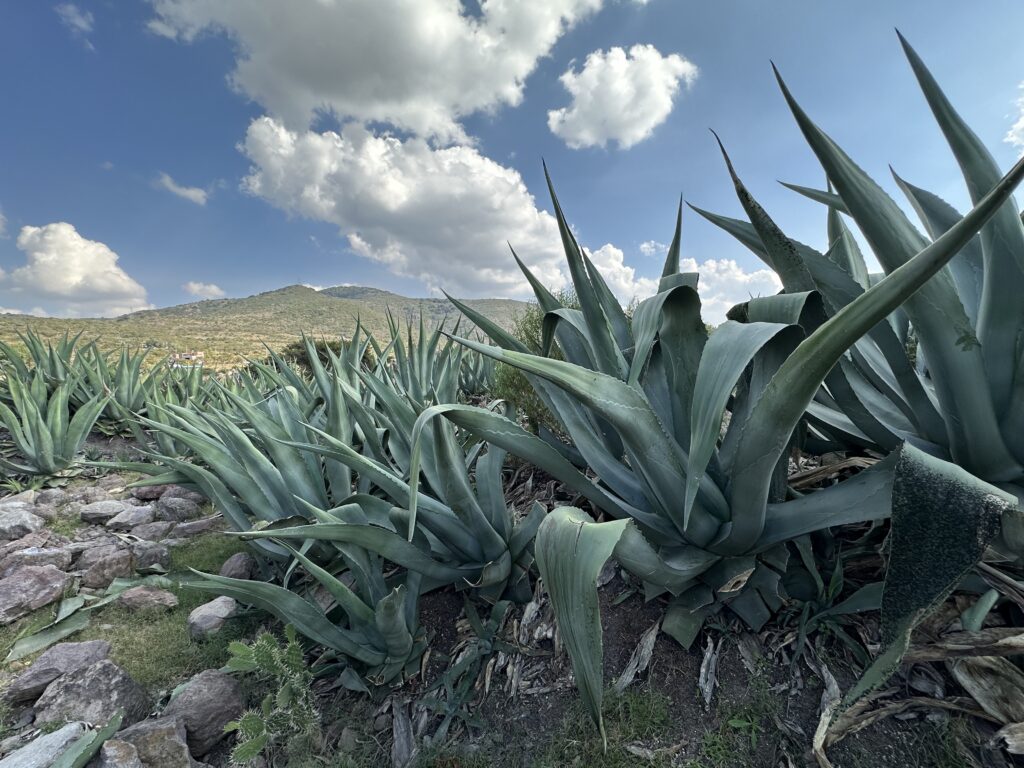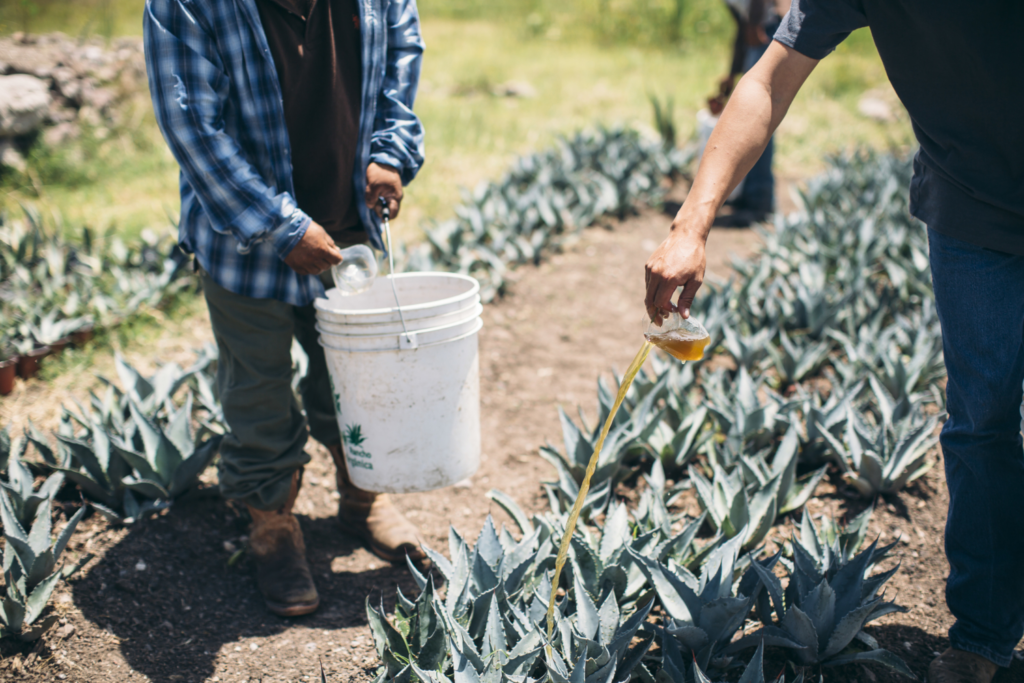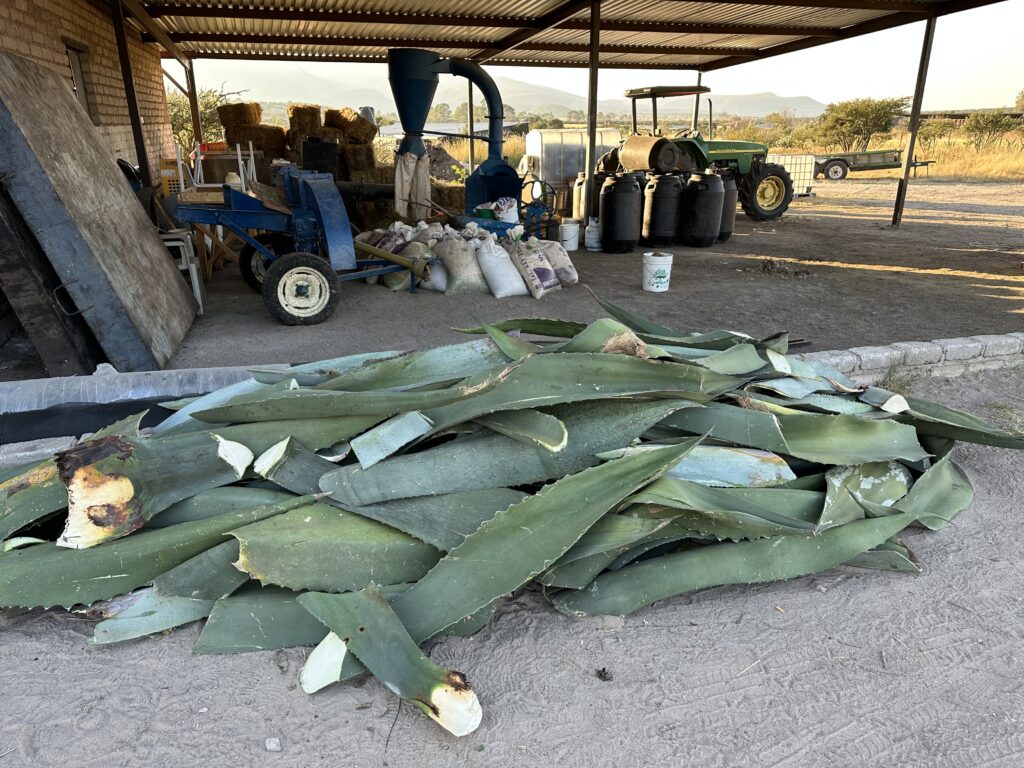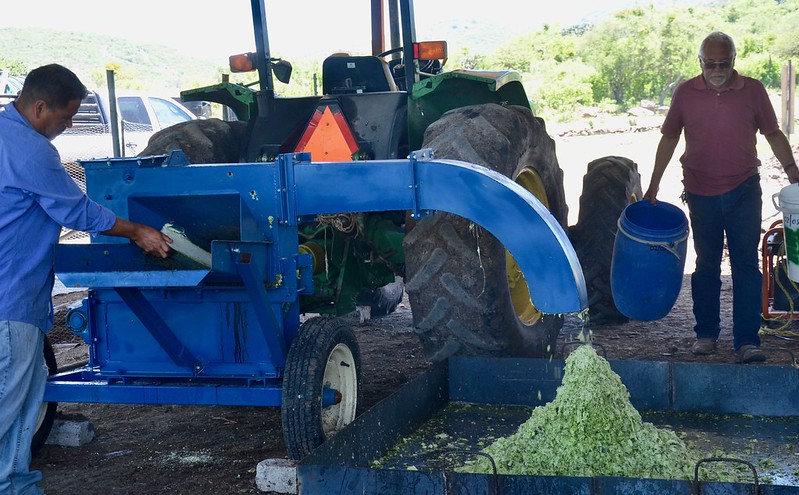

An organization called Vía Orgánica—based in San Miguel de Allende, in the state of Guanajuato—is working with farmers to implement new uses for some of the varieties of agave that grow wild in arid and semiarid areas across Mexico and in many other countries. The idea is to provide additional sources of income for farmers while benefiting the environment.
The leaders of the Billion Agave Project, as it’s known, have lofty ambitions for this humble plant. “We want to cool the planet,” said Juan Frías, who serves as the project’s technical director.
Agave is well suited to the task for many reasons, according to Frías, an agronomist who has a doctorate in biotechnology.
“It doesn’t require irrigation, it doesn’t require agrochemicals, it thrives in poor soils, it thrives with very low precipitation,” he said in an interview, adding that these advantages make the plants more adaptable to arid and semiarid conditions. The pores of the succulent plant stay closed during the day to reduce evaporation and open in the cool of the night to absorb carbon dioxide (CO2).

Agave plants can thrive with no fertilizer or irrigation, in areas with poor soil. Photo courtesy Janelle Conaway.
“Agaves sequester greater amounts of carbon than other plants, similar to a tree,” Frías said.
Eventually, the idea is that farmers participating in the project will be able to earn extra income from carbon credits. Under this type of system, which must be carefully quantified and verified, a company, government, or organization could offset its own carbon footprint by paying farmers for the trees they have planted, since the trees pull greenhouse gases out of the atmosphere and store them in their trunks, leaves, and roots.
In the shorter term, though, the Billion Agave Project has been developing ways for small-scale farmers to profitably grow agave, with or without carbon credits.
This is not about making more tequila; in fact, tequila is subject to denomination-of-origin rules, and its production is restricted to a few areas of Mexico. Rather, the Billion Agave Project has been exploring other uses for a plant that largely goes to waste.
Traditionally, farmers have planted agave (also called maguey) along property lines or in areas that need erosion control, and they may extract the nectar from the heart of the plant to make a fermented drink called pulque. But the large leaves of the agave, called pencas, are generally discarded. Farmers sometimes chop up some of the leaves for their animals, but the raw leaves are hard to digest and the animals don’t like them.
But more than a decade ago, a farming operation in Guanajuato state called Hacienda Zamarripa discovered that by chopping up the leaves finely and fermenting them, they could make inexpensive fodder that their animals liked and thrived on.
Vía Orgánica, which is affiliated with the organization Regeneration International and with the U.S.-based Organic Consumers Association (OCA), started working with Hacienda Zamarripa and others about three years ago and is now working to spread the word about agave.
“What excites us about this system is its ability to be scaled up, not only in Mexico but across the world,” said Ronnie Cummins, a co-founder of OCA and Vía Orgánica and a member of Regeneration International’s steering committee.

At Vía Orgánica’s farm outside San Miguel de Allende, members of the project team share simple techniques for cultivating agave for animal fodder. Photo courtesy viaorganica.org.
He said that an estimated 40% of the world’s land is in arid or semiarid areas, where it is difficult to grow food crops without irrigation and the soil is often depleted from overgrazing. These are also the places where the poorest people tend to live, he added.
As for the target number of agaves to be planted through the project, Cummins said, “a billion is not an exaggeration.” Mexico is already home to several billion agaves, he said, adding that just in the state of Jalisco—the heart of the tequila industry—there are an estimated half a billion blue agave plants under cultivation.
However, he said, when agave is grown as a monoculture, as is often the case with tequila or mezcal production, it does not have the same benefits as when it is grown as part of a well-rounded agroforestry system.
At Vía Orgánica’s farm outside San Miguel de Allende, members of the project team show farmers how to plant agave not as a monoculture but interspersed with mesquite trees, which have deep roots and fix nitrogen into the soil. The trees also produce protein-rich pods that can be ground up and fermented along with the finely chopped agave leaves.
The project recommends that farmers plant 2,000 agave plants and 400 mesquite trees per hectare, Frías said, adding that by about the third year, that combination will yield nearly six tons of fodder per hectare—without having to use water or fertilizer. That amount goes up as the plants mature.
“The maintenance is practically nonexistent,” Frías said. The only thing the farmer has to do, he said, is regularly prune a small percentage of the agave leaves to be used in animal feed.

Farmers bring pruned agave leaves, called pencas, to Vía Orgánica to be ground up and fermented. Photo courtesy Janelle Conaway.
At the Vía Orgánica farm, project field technician Mayra Martínez recently showed some visitors two simple milling machines which can be hooked up to a tractor and used to grind up agave leaves and mesquite pods. The ground materials are then mixed together and sealed into plastic drums or some other container so that the sugars in the pencas can ferment the mixture. After 30 days of fermentation, the feed is ready to eat, and if left in the closed containers, it will keep for two years or more.
Farmers in the area around Vía Orgánica can bring their leaves and pods to be milled, leaving a percentage of the fodder to the organic farm as payment. The farm feeds the fodder to its goats and sheep, and even small amounts to the pigs and chickens.
Around 200 species of agave exist in the world, according to Frías, who added that 75% of the species can be found in Mexico and about half are endemic to the country. He has been experimenting with different species to determine relative benefits and has concluded that the agave species used for pulque potentially could prove more profitable than the kind used for tequila.

Vía Orgánica uses a simple milling machine hooked up to a tractor to grind up agave leaves. Photo courtesy viaorganica.org.
For example, agave can be used to make a dietary fiber called inulin and a syrup that serves as a sugar substitute, as well as pellets used in pet food, all uses that can attract private investment. Frías said his dream is to someday establish an agave research institute to investigate the plant’s varied uses.
Cummins is convinced that the model the Billion Agave Project has been developing will work well in the Southwestern United States, where drought is putting pressure on water systems. Once U.S. farmers start to use agave for animal forage, he said, “the rest of world is really going to sit up and take notice.”
In Mexico, meanwhile, he sees in agave the potential for farmers to make enough money to stay on their land and not be forced to migrate north to support their families. “You don’t have to be able to get rich, but you do have to be able to make a living,” he said.
This sort of initiative needs private investment, carbon credits, and government support to reach its full potential as a positive step to addressing climate change, Cummins said.
“This is a no-brainer,” he said. “If you can do something that will reduce poverty, reduce forced migration, is good for the animals, good for the environment, and is very, very, very low cost compared to everything else, well, why wouldn’t you do it?”
 View Map
View Map